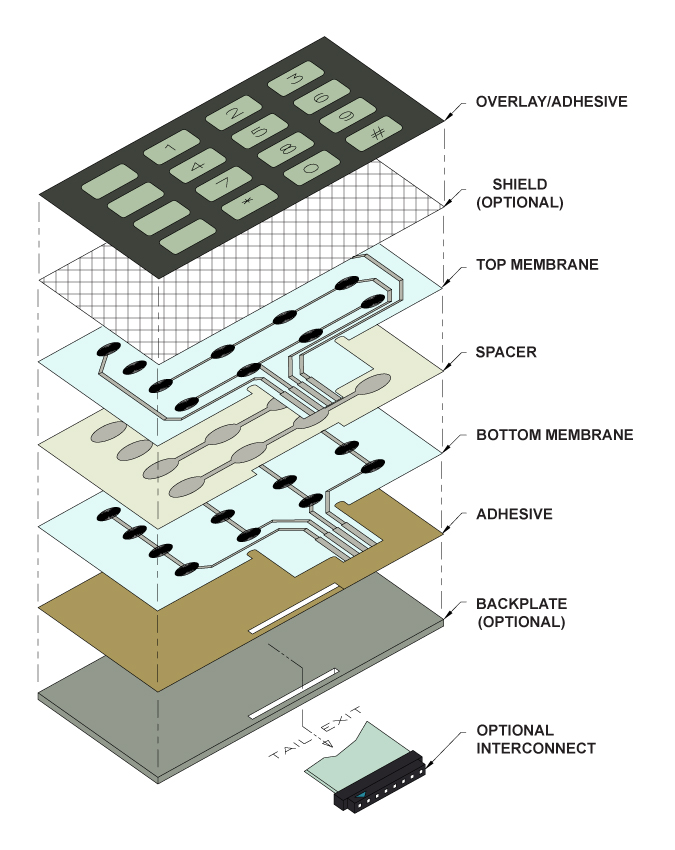Membrane Switches: A Budget-Friendly Solution for Contemporary Control Systems
Membrane Switches: A Budget-Friendly Solution for Contemporary Control Systems
Blog Article
Membrane Switch Innovation: The Trick to Dependable and Cost-efficient Interfaces
Membrane switch technology has emerged as an essential part in the layout of individual interfaces, supplying both dependability and cost-effectiveness across a diverse range of applications. As we explore the diverse advantages of membrane buttons, their possibility for technology increases concerns about future applications and developing trends.
Understanding Membrane Layer Switch Over Modern Technology
Membrane switch innovation is a widely used user interface remedy in various electronic gadgets, providing a seamless mix of functionality and style. This technology integrates multiple layers of products, typically consisting of a visuals overlay, spacer layer, and a circuit layer. The graphic overlay presents the user interface elements, while the spacer layer divides the circuit layer from the overlay up until an individual activates a button.
When pressure is related to the overlay, the circuit layer finishes the electrical circuit, sending out a signal to the gadget. This mechanism allows for various arrangements, consisting of responsive comments and backlighting alternatives, improving user communication. Membrane buttons are normally manufactured making use of long lasting materials such as polyester or polycarbonate, making certain durability and resistance to environmental aspects like moisture and dirt.
The versatility of membrane switches allows their application in varied sectors, including clinical devices, customer electronic devices, and industrial controls. Their compact layout permits assimilation into space-constrained environments, supplying an efficient individual interface without endangering aesthetic allure. Comprehending the complexities of membrane button modern technology is vital for manufacturers and designers looking for to create dependable and efficient human-machine interfaces.
Key Advantages of Membrane Layer Switches
While various interface solutions exist, membrane layer switches over offer unique benefits that make them a recommended choice in numerous applications. One of the key advantages is their sturdiness; membrane layer buttons are designed to stand up to harsh ecological problems, consisting of moisture, dust, and temperature changes, making certain long-lasting efficiency. This strength significantly decreases the demand for constant substitutes, thus lowering general maintenance prices.

In addition, membrane layer buttons are light-weight and small, making them appropriate for applications where area is restricted. Their low-profile design contributes to a sleek look without endangering capability.
Cost-effectiveness is also a noteworthy benefit, as the production procedure for membrane layer switches over tends to be cheaper compared to typical mechanical buttons. This affordability, integrated with their dependability and ease of setup, positions membrane switches over as a functional solution for a large range of markets seeking effective and effective interface.
Applications Across Numerous Industries
Exactly how do membrane switches adjust to the diverse requirements of various industries? Membrane button technology is progressively identified for its flexibility, making it appropriate for a wide variety of applications across multiple markets.
In customer electronics, membrane layer buttons provide a compact service for remotes and home appliances, improving customer experience through intuitive style. Furthermore, the commercial sector leverages membrane layer switches for equipment control board, gaining from their resistance to rough environments, such as wetness and dirt.
Military and aerospace applications also use membrane switches for their integrity and capacity to endure severe conditions, guaranteeing operational webpage efficiency in critical situations. Furthermore, the food and drink market adopts these switches for automated systems, where hygiene and ease of operation are vital. Ultimately, membrane buttons are tailored to meet the unique needs of each sector, confirming their crucial duty in modern technology interfaces
Style and Modification Alternatives

In the realm of membrane layer button innovation, design and customization choices play a crucial duty in improving capability and customer communication. These buttons can be customized to meet particular operational requirements and visual choices, making them versatile elements in different applications.
Among the main modification options is the layout of the button itself, which can be designed to accommodate unique interface and ergonomic considerations. By changing the form, size, and arrangement of switches, producers can develop intuitive styles you can look here that promote simplicity of use. Additionally, the unification of different shades and graphic overlays enables branding and boosted presence, ensuring their website that customers can promptly determine functions.
Furthermore, membrane layer switches can be engineered with numerous tactile responses devices, such as increased buttons or distinct clicks, to improve the customer experience. Various materials can likewise be picked for longevity and ecological resistance, addressing factors such as wetness, temperature variations, and chemical exposure.
Inevitably, the considerable layout and modification alternatives offered in membrane button modern technology encourage organizations to produce customized services that not only fulfill useful demands yet also straighten with their branding and operational needs.

Future Trends in Membrane Buttons
As membrane layer switch technology continues to develop, future patterns are progressively concentrated on enhancing individual experience and incorporating advanced functionalities. One considerable pattern is the assimilation of touch-sensitive and capacitive innovations into traditional membrane layer buttons. This advancement enables even more instinctive interface, giving responsive feedback while maintaining a streamlined layout.
Another arising fad is using eco-friendly products, driven by the growing need for lasting production methods. Manufacturers are looking for to reduce their carbon footprint by utilizing recyclable substrates and low-impact inks, lining up with international sustainability goals.
Additionally, the rise of the Internet of Things (IoT) is motivating the incorporation of wise functions right into membrane switches. Boosted connectivity options will allow gadgets to interact with each other, allowing for smooth assimilation right into wider systems.
Furthermore, developments in printing innovations, such as electronic printing, are allowing for higher layout versatility and customization. This allows makers to generate intricate layouts and lively shades cost-effectively.

Verdict
In final thought, membrane layer button modern technology stands for a vital technology in user interface style, offering considerable benefits in durability, customization, and cost-effectiveness. As developments continue to emerge, specifically in touch-sensitive interfaces and lasting products, the capacity for membrane switches to boost user experience and capability remains appealing.
Report this page